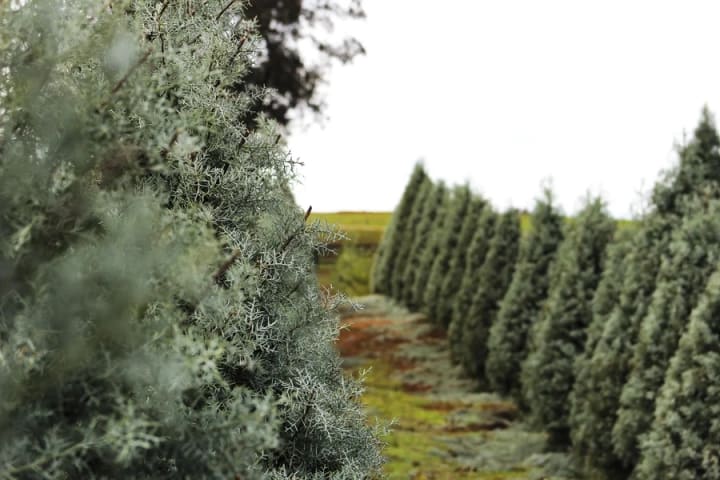Real vs Fake Christmas Tree… Which is Better?
Wondering which is better for the environment? A real or fake tree? Check out all the facts here!

So this was originally included in my post a few days ago. (Tips for an Eco-Friendly Holiday Season) However, as I was doing my research, I realized there was SO much to say about this topic. I decided it needed its own post!
Having a Christmas tree is one of my absolute favorite holiday traditions.
When I was little, growing up in New Jersey, every year we’d cut down our own tree. It was such a fun tradition. We’d spend so much time finding the right tree and then we’d help our dad and grandpa cut It down. The whole day was filled with holiday music, hot chocolate, and lots of food. It was an incredible family tradition that I will always cherish the memories of.
However, since I’ve been living on my own, I’ve been using a plastic tree.
I really wanted to get to the bottom of which one is better for the environment, which ended up being harder than I thought. Most of the information I found stated that real trees were more environmentally friendly, but It really does depend. There are some situations where having a fake tree is better!
Before I get started, I do want to clarify that this is only comparing the trees on an environmental standpoint. There are tons of other pros and cons to both fake and real Christmas trees, but I will not be mentioning those! When I say ‘better’ or ‘worse’, I’m ONLY referring to the impact on our environment.

Now if you get a fake Christmas tree, obviously, the intention is to reuse It as much as possible. If you only bought one fake tree your whole life, well that would be ideal. Surprisingly though, according to the American Christmas Tree Association, if a household makes use of a fake tree for at least four years, its carbon footprint will actually be smaller than that of a home with a real tree
But if (and when) you do have to throw It away, that fake Christmas tree is not breaking down AT ALL. It’s going to be in a landfill for the rest of time.
Whereas, real trees are 100% degradable. They can easily be converted or reused into mulch or other recycled products.
The other problem is where the fake trees are coming from. In the U.S., around 10 million artificial trees are purchased each season and nearly 90 percent of them are shipped across the world from China. This obviously results in a huge increase of carbon emissions and resources.
In fact, according to The Guardian, a 6.5-foot tree has a carbon footprint of about 88.18 pounds of greenhouse gas emissions. That’s more than twice that of a live tree.

It also is going to depend if the real trees you buy come from your area or not. If Pine trees are native to your area, or you have an active Christmas tree farm locally, then getting a real tree is supporting the local farmers and businesses.
However, if you live somewhere that doesn’t grow them natively or have active Christmas tree farms, It is NOT economical to buy a real one. If they have to package and ship them to your area, get a fake one!
The other problem with this is it can introduce pesticides, bugs, plant diseases, and animals that are NOT native to that area. That can impact the environment very negatively.

Now what about the environmental impact of Christmas tree farms in general?
For starters, pine trees can grow in many areas that can’t support other plants or buildings. According to the National Christmas Tree Association (NCTA), there are close to 15,000 Christmas tree farms located across the country that employ over 100,000 people. The top Christmas tree-producing states are Oregon, North Carolina, Michigan, Pennsylvania, Wisconsin, and Washington. Out of the 350-500 million growing on tree farms across the U.S., only 30 million trees are harvested for Christmas each year. This means that there are about 10x the amount of trees left than ones cut down each year.
We also have to look at the other benefits of the Christmas tree farms. They provide habitats for tons of local wildlife. This can include owls, squirrels, chipmunks, insects, and many more.
Now let’s think about the carbon monoxide input and oxygen output from these trees. There are about one million acres of Christmas tree farms in the U.S. and each one provides the daily oxygen requirements of around 18 people.
According to the National Christmas Tree Association, real Christmas trees grow seven years on average, before they’re tall enough to be cut down. That is seven years that each tree is producing oxygen and reducing carbon dioxide emissions.
New trees are also being replanted all the time. For every tree cut down, farmers plant 1-3 more seedlings.
Other tips for Christmas trees:
-If you do buy a fake tree, buy a classic looking one. Don’t go with the white or bright pink that comes in and out of style. Get one you will always enjoy.
-Try to avoid the pre-lit ones. The lights will break long before the tree will. Plus, when you get your own lights you have the choice of what kind you want to get!
-Check for used ones first! Thrift stores, Craigslist, OfferUp, and Facebook marketplace are just some of the many places to find used holiday decorations!
As you can see, there was A LOT to learn about the real vs fake Christmas tree debate. No matter what you gathered from this article, I hope you know it’s YOUR decision. Whatever you believe is the right choice for you and your family, is what you should do! All I ask is you take a couple extra seconds to think about the environmental impact before purchasing your tree!
As always, thanks for listening and joining in on this journey!
About the Creator
Jessica Uhl
Hello! I am a full time traveler, a business owner, a fur baby momma, a writer, a photographer, an environmentally conscious lifestyle advocate, an athlete, and so much more!






Comments
There are no comments for this story
Be the first to respond and start the conversation.